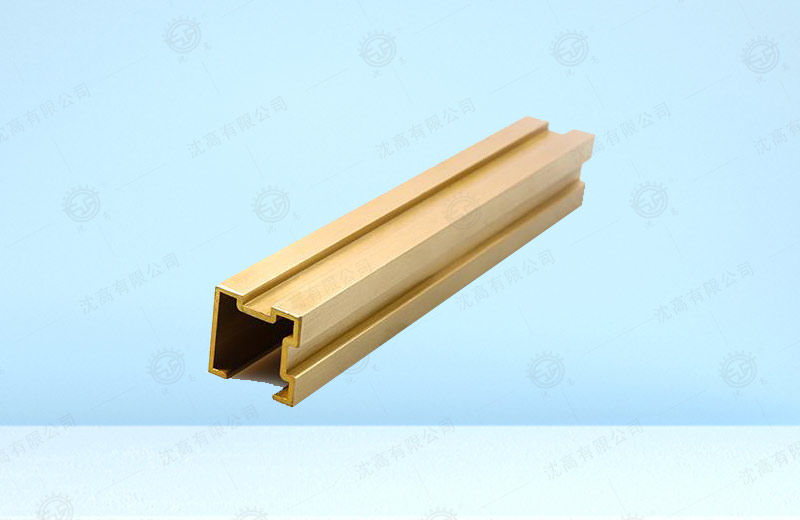Brass is an alloy consisting of copper and zinc
White copper is an alloy of copper and nickel
Bronze is an alloy of copper with elements other than zinc and nickel, mainly tin bronze, aluminum bronze, etc
Red copper is copper with high content, and the total content of other impurities is less than 1%.
Red copper is pure copper, also known as red copper, pure copper density of 8.96, melting point of 1083℃. Has good electrical conductivity and thermal conductivity, excellent plasticity, easy to hot pressing and cold pressure processing, a large number of used in the manufacture of wire, cable, brush, special electric spark corrosion copper and other requirements of good electrical conductivity products.
It gets its name from its purplish red color. It is not necessarily pure copper, and sometimes a small amount of deoxidizing elements or other elements are added to improve the material and performance, so it is also classified as copper alloy. According to composition, Chinese copper processing materials can be divided into four categories: ordinary copper (T1, T2, T3, T4), oxygen-free copper (Tu1, Tu2 and high purity, vacuum oxygen-free copper), deoxygenated copper (TUP, TUMN), and special copper (arsenic copper, tellurium copper, silver-copper) with a small amount of alloying elements.
The electrical conductivity and thermal conductivity of red copper is second only to silver, widely used in the production of electrical and thermal conductivity equipment. Copper in the atmosphere, sea water and some non-oxidizing acid (hydrochloric acid, dilute sulfuric acid), alkali, salt solution and a variety of organic acids (acetic acid, citric acid), has good corrosion resistance, used in chemical industry. In addition, copper has good weldability, can be cold, thermoplastic processing into a variety of semi-finished products and finished products. In the 1970s, the production of copper exceeded the combined production of all other copper alloys.
The trace impurities in copper have a serious effect on the electrical and thermal conductivity of copper. Among them, titanium, phosphorus, iron and silicon significantly reduce the electrical conductivity, while cadmium and zinc have little effect. The solid solubility of oxygen, sulfur, selenium, tellurium in copper is very small, and can form brittle compounds with copper, which has little effect on the electrical conductivity, but can reduce the processing plasticity. When ordinary copper is heated in a reducible atmosphere containing hydrogen or carbon monoxide, hydrogen or carbon monoxide is easy to interact with cuprous oxide (Cu2O) at the grain boundary to produce high-pressure water vapor or carbon dioxide gas, which can make copper crack. This phenomenon is often referred to as copper's "hydrogen disease". Oxygen is harmful to the weldability of copper. Bismuth or lead form eutectic with copper at low melting point, which makes copper produce hot embrittlement. When the brittle bismuth is distributed in the grain boundary as thin film, the copper will be cold and brittle. Phosphorus can significantly reduce the electrical conductivity of copper, but increase the fluidity of copper liquid and improve the weldability. An appropriate amount of lead, tellurium, sulfur, etc., can improve machinability.
Brass: Copper alloy with zinc as the main additive element, having a beautiful yellow color, collectively called brass. The binary alloy of copper and zinc is called ordinary brass or simple brass. Brasses with three ternary or more are called special or complex brasses. Brass alloy with zinc less than 36% is composed of a solid solution, with good cold working properties, such as brass with zinc 30% is commonly used to make cartridge case, commonly known as cartridge case brass or seven three brass. Brass alloys containing zinc between 36 and 42% are composed of solid solutions, among which hexa four brass containing 40% zinc is commonly used. In order to improve the performance of ordinary brass, other elements are often added, such as aluminum, nickel, manganese, tin, silicon, lead, etc. Aluminum can improve the strength, hardness and corrosion resistance of brass, but reduce the plasticity, so it is suitable for sea ship condensate tubes and other corrosion resistance parts. Tin can improve the strength of brass and corrosion resistance to sea water, so it is called naval brass, used for ship thermal equipment and propeller, etc. Lead can improve the cutting property of brass. This free cutting brass is often used as clock parts. Brass castings are commonly used for valve and pipe fittings.
Bronze: originally refers to copper tin alloy, after except brass, white copper alloy are called bronze,. Tin bronze has good foundry, antifriction and mechanical properties, and is suitable for the manufacture of bearings, worm gear, gears, etc. Lead bronze is a widely used bearing material for modern engines and grinders. Aluminum bronze has high strength, good wear resistance and corrosion resistance, and is used for casting high load gears, bushings, Marine propellers, etc. Beryllium bronze and phosphor bronze have high elastic limits and good electrical conductivity, making them suitable for precision springs and electrical contact elements. Beryllium bronze is also used to make sparkless tools for coal mines, oil depots, etc.
White copper: Copper alloy with nickel as the main added element. Cu-Ni binary alloy is called ordinary white copper; The white copper alloy with manganese, iron, zinc, aluminum and other elements is called complex white copper. Industrial white copper is divided into structural white copper and electrical white copper two categories. Structural white copper is characterized by good mechanical properties and corrosion resistance and beautiful color. This white copper is widely used in precision machinery, chemical machinery and building blocks for ships. Electrical white copper generally has good thermoelectric properties.
Manganese copper, constantan and copper are manganese white copper with different manganese content, which are used in manufacturing precision electrical instruments, rheostat, precision resistor, strain gauge, thermocouple and so on.







